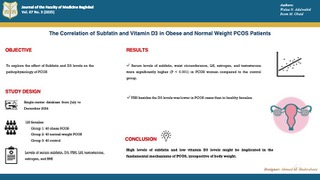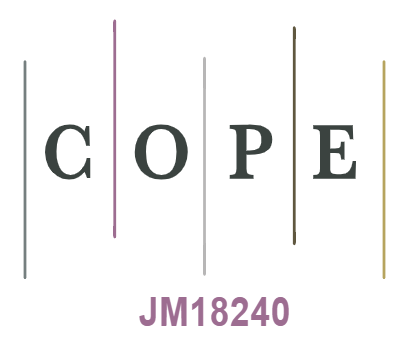تقييم مستوى السبفاتين وفيتامين D3 لمريضات تكيس المبايض البدينات وذوات الوزن الطبيعي
DOI:
https://doi.org/10.32007/jfacmedbaghdad3151الكلمات المفتاحية:
سوبفاتين، متلازمة تكيس المبايض، السمنةالملخص
Background: Polycystic ovarian syndrome (PCOS) is a complex endocrine problem affecting women with an estimated global prevalence of 9%, due to inherited and environmental causes. PCOS mainly impacts women aged 15-35 years, and women who are at their earliest or final period of pregnancy. Subfatin is a newly identified hormone that controls metabolism and is thought to be a biomarker for PCOS and metabolic syndrome. Vitamin D3 has an important function in the development of PCOS.
Objective: To explore the effect of obesity on Subfatin and D3 levels, and the impact of the pathophysiology of PCOS on Subfatin and D3 levels.
Methods: The total number of participants was 120: 80 females with PCOS, divided to 40 obese and 40 normal-weight, and 40 healthy females (controls). The current investigation was carried out from July to December 2024 at Kamal Al-Samarrai hospital in Baghdad, Iraq. The enzyme-linked immunosorbent assay (ELISA) was used to determine the subfatin serum levels. Body mass index, follicle-stimulating hormone (FSH), testosterone, estrogen, D3, and luteinizing hormone (LH) levels were all assessed. The data were examined with the origin lab software version 25. The study groups were compared using Analysis of variance (ANOVA).
Results: Serum levels of subfatin, waist circumference, LH, estrogen, and testosterone were significantly higher (P < 0.001) in PCOS women compared to the control group. FSH besides the D3 levels was lower in PCOS cases than in healthy females.
Conclusion: High levels of subfatin and low vitamin D3 levels might be implicated in the fundamental mechanisms of PCOS, irrespective of body weight.
التنزيلات
المراجع
1. Kamber HM, Hussein WA, Al-Sattam ZM, Al-Jawdah K, Muter S, Al-Musawi S. Polycystic Ovary Syndrome and Urinary Tract Stones: A Body Mass Index-Adjusted Analysis in Iraqi Women. AJMS. 2025 Mar 14;8(1):185-8. https://doi.org/10.54133/ajms.v8i1.1725. DOI: https://doi.org/10.54133/ajms.v8i1.1725
2. Cunha A, Póvoa AM. Infertility management in women with polycystic ovary syndrome: a review. Porto biomedical journal. 2021 Jan 1;6(1):e116. https://doi.org/10.1097/j.pbj.0000000000000116. DOI: https://doi.org/10.1097/j.pbj.0000000000000116
3. Houston EJ, Templeman NM. Reappraising the relationship between hyperinsulinemia and insulin resistance in PCOS. Journal of Endocrinology. 2025 May 1;265(2). https://doi.org/10.1530/JOE-24-0269. DOI: https://doi.org/10.1530/JOE-24-0269
4. Alizadeh H. Meteorin-like protein (Metrnl): A metabolic syndrome biomarker and an exercise mediator. Cytokine. 2022 Sep 1;157:155952. https://doi.org/10.1016/j.cyto.2022.155952. DOI: https://doi.org/10.1016/j.cyto.2022.155952
5. Huang S, Cao L, Cheng H, Li D, Li Y, Wu Z. The blooming intersection of subfatin and metabolic syndrome. Reviews in Cardiovascular Medicine. 2021 Sep 24;22(3):799-805. https://doi.org/10.31083/j.rcm2203086. DOI: https://doi.org/10.31083/j.rcm2203086
6. Ghudhaib KK, Khaleel FM, Ali FE. Evaluation of DPP4, TNF, and Lipid Profile Levels as Early Indicators in Infertility Among Iraqi Women. Baghdad Science Journal. 2025;22(5):1501-10. https://doi.org/10.21123/bsj.2024.11669. DOI: https://doi.org/10.21123/bsj.2024.11669
7. Kaur R, Kaur M. Evaluation of potential association of metabolic syndrome in obese and non-obese PCOS women. Middle East Fertility Society Journal. 2024 Jan 26;29(1):9. https://doi.org/10.1186/s43043-024-00170-0. DOI: https://doi.org/10.1186/s43043-024-00170-0
8. Gokosmanoglu F, Onmez A, Ergenç H. The relationship between Vitamin D deficiency and polycystic ovary syndrome. African health sciences. 2020 Dec 16;20(4):1880-6. https://doi.org/10.4314/ahs.v20i4.45. DOI: https://doi.org/10.4314/ahs.v20i4.45
9. Al-Qazzaz HA, Al-Taie FA. Estimation of paraoxonase-1 and dipeptidyl peptidase in Iraqi prostatic cancer with hormones and chemotherapy drugs: a cross-sectional study. Baghdad Science Journal. 2025;22(8):2488-99
https://doi.org/10.21123/2411-7986.5012. DOI: https://doi.org/10.21123/2411-7986.5012
10. Zhang M, Li P, Zhu Y, Chang H, Wang X, Liu W, et al. Higher visceral fat area increases the risk of vitamin D insufficiency and deficiency in Chinese adults. Nutr Metab (Lond). 2015 Nov 25:12:50. doi: 10.1186/s12986-015-0046-x. eCollection 2015. https://doi.org/10.1186/s12986-015-0046-x. DOI: https://doi.org/10.1186/s12986-015-0046-x
11. Kazeminia M, Rajati F, Rasulehvandi R, Rajati M. The effect of vitamin D on the hormonal profile of women with polycystic ovarian syndrome: a systematic review and meta-analysis. Middle East Fertility Society Journal. 2024 Aug 24;29(1):45. https://doi.org/10.1186/s43043-024-00201-w. DOI: https://doi.org/10.1186/s43043-024-00201-w
12. Majeed AA, Al-Qaisi AH, Ahmed WA. The Comparison of Irisin, Subfatin, and Adropin in Normal-Weight and Obese Polycystic Ovary Syndrome Patients. IJMS. 2024 Jun 1;49(6):350. https://doi.org/10.30476/ijms.2023.99130.3117.
13. Fouani FZ, Fadaei R, Moradi N, Zandieh Z, Ansaripour S, Yekaninejad MS, et al. Circulating levels of Meteorin-like protein in polycystic ovary syndrome: A case-control study. PloS one. 2020 Apr 24;15(4):e0231943. https://doi.org/10.1371/journal.pone.0231943. DOI: https://doi.org/10.1371/journal.pone.0231943
14. Cheng JX, Yu K. New discovered adipokines associated with the pathogenesis of obesity and type 2 diabetes. Diabetes, metabolic syndrome and obesity: targets and therapy. 2022 Jan 1:2381-9.. https://doi.org/10.2147/DMSO.S376163. DOI: https://doi.org/10.2147/DMSO.S376163
15. Yang J, Chen C. Hormonal changes in PCOS. JOE. 2024 Apr 1;261(1). https://doi.org/10.1530/JOE-23-0342
https://doi.org/10.1530/JOE-23-0342. DOI: https://doi.org/10.1530/JOE-23-0342
16. Shaheed HS, Abbass WA, Jasim SY. Correlation between serum Bisphenol-a level, luteinizing hormone (LH), follicular stimulating hormone (FSH) in a sample of Iraqi women with PCOS. IJPR. 2021 Jan 1;13(1):1963-66. https://doi.org/10.31838/ijpr/2021.13.01.290. DOI: https://doi.org/10.31838/ijpr/2021.13.01.290
17. Saleh BO, Al-Naddawi AM. Association between serum fructose level and insulin resistance in women with polycystic ovary syndrome: The effect of obesity. JFacMedBaghdad. 2022 Jul 24;64(2):91-5. https://doi.org/10.32007/jfacmedbagdad.6421926. DOI: https://doi.org/10.32007/jfacmedbagdad.6421926
18. Shan D, Zhao J, Lu X, Zhang H, Lu J, Shen Q. Effect of basal luteinizing hormone/follicle-stimulating hormone ratio on clinical outcome of In Vitro fertilization in patients with polycystic ovarian syndrome: a retrospective cohort study. PeerJ. 2024 Nov 26;12:e18635. https://doi.org/10.7717/peerj.18635. DOI: https://doi.org/10.7717/peerj.18635
19. Ibrahim SK, Alsaffar SF. Assessment of monocyte chemoattractant protein-1 and fertility hormones in Iraqi women with polycystic ovarian syndrome. IJPAS. 2024 Jan 20;37(1):86-93. https://doi.org/10.30526/37.1.3307. DOI: https://doi.org/10.30526/37.1.3307
20. Saadia Z. Follicle stimulating hormone (LH: FSH) ratio in polycystic ovary syndrome (PCOS)-obese vs. non-obese women. Medical Archives. 2020 Aug;74(4):289. https://doi.org/10.5455/medarh.2020.74.289-293 DOI: https://doi.org/10.5455/medarh.2020.74.289-293
21. Kim JJ. Obesity and Polycystic Ovary Syndrome. JOMS. 2024 Dec 20;33(4):289. https://doi.org/10.7570/jomes24035. DOI: https://doi.org/10.7570/jomes24035
22. Abdalla MA, Deshmukh H, Mohammed I, Atkin S, Reid M, Sathyapalan T. The effect of free androgen index on the quality of life of women with polycystic ovary syndrome: a cross-sectional study. FPhys. 2021 May 24;12:652559. https://doi.org/10.3389/fphys.2021.652559. DOI: https://doi.org/10.3389/fphys.2021.652559
23. Ibraheem QA, Al Obaidy LH, Nasir GA, Al Obaidi MT. Fat mass and obesity association gene polymorphism in PCOS Iraqi women. BSJ. 2020 Sep 8;17(3 (Suppl.)):1103. https://doi.org/10.21123/bsj.2020.17.3(Suppl.).1103 DOI: https://doi.org/10.21123/bsj.2020.17.3(Suppl.).1103

التنزيلات
منشور
إصدار
القسم
الفئات
الرخصة
الحقوق الفكرية (c) 2025 Walaa N. Abdulwahid, Reem M. Obaid

هذا العمل مرخص بموجب Creative Commons Attribution 4.0 International License.










 Creative Commons Attribution 4.0 International license..
Creative Commons Attribution 4.0 International license..


